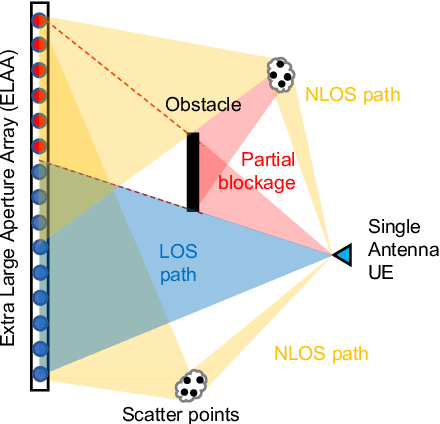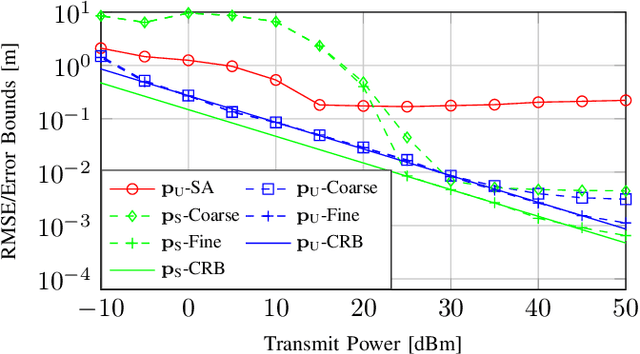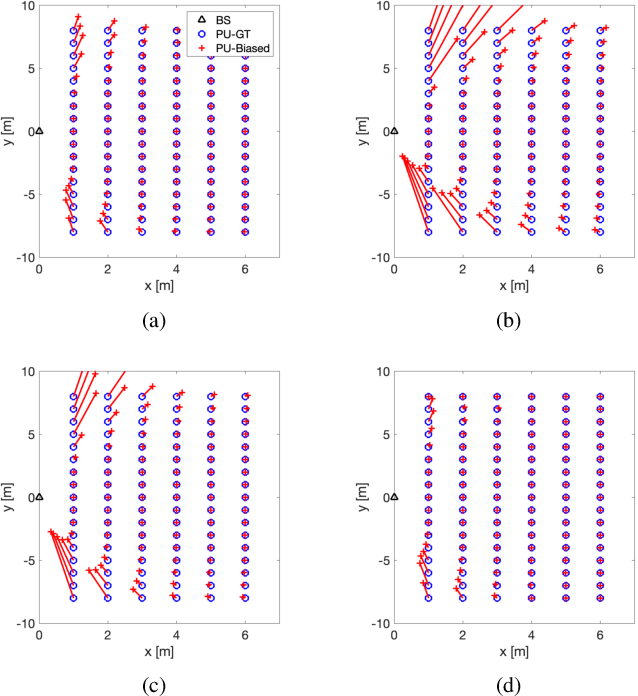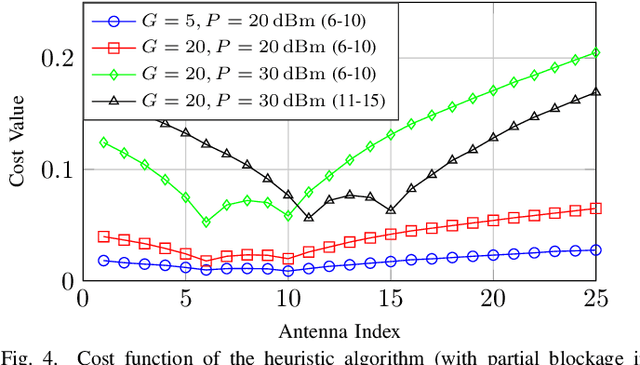Ahmed Elzanaty
SCNR Maximization for MIMO ISAC Assisted by Fluid Antenna System
Apr 02, 2025Abstract:The integrated sensing and communication (ISAC) technology has been extensively researched to enhance communication rates and radar sensing capabilities. Additionally, a new technology known as fluid antenna system (FAS) has recently been proposed to obtain higher communication rates for future wireless networks by dynamically altering the antenna position to obtain a more favorable channel condition. The application of the FAS technology in ISAC scenarios holds significant research potential. In this paper, we investigate a FAS-assisted multiple-input multiple-output (MIMO) ISAC system for maximizing the radar sensing signal-clutter-noise ratio (SCNR) under communication signal-to-interference-plus-noise ratio (SINR) and antenna position constraints. We devise an iterative algorithm that tackles the optimization problem by maximizing a lower bound of SCNR with respect to the transmit precoding matrix and the antenna position. By addressing the non-convexity of the problem through this iterative approach, our method significantly improves the SCNR. Our simulation results demonstrate that the proposed scheme achieves a higher SCNR compared to the baselines.
EMF-Efficient MU-MIMO Networks: Harnessing Aerial RIS Technology
Dec 08, 2024



Abstract:The rollout of the fifth-generation (5G) networks has raised some concerns about potential health effects from increased exposure to electromagnetic fields (EMF). To address these concerns, we design a novel EMF-aware architecture for uplink communications. Specifically, we propose an aerial reconfigurable intelligent surface (ARIS) assisted multi-user multiple-input multiple-output (MIMO) system, where the ARIS features a reconfigurable intelligent surface (RIS) panel mounted on an unmanned aerial vehicle (UAV), offering a flexible and adaptive solution for reducing uplink EMF exposure. We formulate and solve a new problem to minimize the EMF exposure by optimizing the system parameters, such as transmit beamforming, resource allocation, transmit power, ARIS phase shifts, and ARIS trajectory. Our numerical results demonstrate the effectiveness of EMF-aware transmission scheme over the benchmark methods, achieving EMF reductions of over 30% and 90% compared to the fixed ARIS and non-ARIS schemes, respectively.
Joint Coverage and Electromagnetic Field Exposure Analysis in Downlink and Uplink for RIS-assisted Networks
Nov 30, 2024



Abstract:Reconfigurable intelligent surfaces (RISs) have shown the potential to improve signal-to-interference-plus-noise ratio (SINR) related coverage, especially at high-frequency communications. However, assessing electromagnetic filed exposure (EMFE) and establishing EMFE regulations in RIS-assisted large-scale networks are still open issues. This paper proposes a framework to characterize SINR and EMFE in such networks for downlink and uplink scenarios. Particularly, we carefully consider the association rule with the presence of RISs, accurate antenna pattern at base stations (BSs), fading model, and power control mechanism at mobile devices in the system model. Under the proposed framework, we derive the marginal and joint distributions of SINR and EMFE in downlink and uplink, respectively. The first moment of EMFE is also provided. Additionally, we design the compliance distance (CD) between a BS/RIS and a user to comply with the EMFE regulations. To facilitate efficient identification, we further provide approximate closed-form expressions for CDs. From numerical results of the marginal distributions, we find that in the downlink scenario, deploying RISs may not always be beneficial, as the improved SINR comes at the cost of increased EMFE. However, in the uplink scenario, RIS deployment is promising to enhance coverage while still maintaining EMFE compliance. By simultaneously evaluating coverage and compliance metrics through joint distributions, we demonstrate the feasibility of RISs in improving uplink and downlink performance. Insights from this framework can contribute to establishing EMFE guidelines and achieving a balance between coverage and compliance when deploying RISs.
Single Antenna Tracking and Localization of RIS-enabled Vehicular Users
Nov 23, 2024



Abstract:Reconfigurable Intelligent Surfaces (RISs) are envisioned to be employed in next generation wireless networks to enhance the communication and radio localization services. In this paper, we propose novel localization and tracking algorithms exploiting reflections through RISs at multiple receivers. We utilize a single antenna transmitter (Tx) and multiple single antenna receivers (Rxs) to estimate the position and the velocity of users (e.g. vehicles) equipped with RISs. Then, we design the RIS phase shifts to separate the signals from different users. The proposed algorithms exploit the geometry information of the signal at the RISs to localize and track the users. We also conduct a comprehensive analysis of the Cramer-Rao lower bound (CRLB) of the localization system. Compared to the time of arrival (ToA)-based localization approach, the proposed method reduces the localization error by a factor up to three. Also, the simulation results show the accuracy of the proposed tracking approach.
A Physical Layer Security Framework for Integrated Sensing and Semantic Communication Systems
Oct 08, 2024


Abstract:In this paper, we address a physical layer security (PLS) framework for the integrated sensing and semantic communication (ISASC) system, where a multi-antenna dual-function semantic base station serves multiple single-antenna semantic communication users (SCUs) and monitors a malicious sensing target (MST), in the presence of a single-antenna eavesdropper (EVE), with both the MST and EVE aiming to wiretap information from the SCUs' signals. To enhance PLS, we employ joint artificial noise (AN) and dedicated sensing signal (DSS) in addition to wiretap coding. To evaluate the sensing accuracy, we derive the Cramer-Rao bound (CRB) as a function of the communication, sensing, and AN beamforming (BF) vectors. Subsequently, to assess the PLS level of the ISASC system, we determine a closed-form expression for the semantic secrecy rate (SSR). To achieve an optimal trade-off region between these two competing objectives, we formulate a multi-objective optimization problem for the joint design of the BF vectors. We apply semi-definite programming, Gaussian randomization method, and golden-section search techniques to address this problem. Simulation results demonstrate that the proposed scheme outperforms baseline schemes, achieving a superior trade-off between SSR and CRB.
EMF-Aware Waveform for Dual-functional Radar Communication Systems
Sep 24, 2024



Abstract:Emerging dual-functional radar communication(RadCom) systems promise to revolutionize wireless systems by enabling radar sensing and communication on a shared platform, thereby enhancing spectral efficiency. However, the high transmit power required for efficient radar operation poses risks by potentially exceeding the electromagnetic field (EMF) exposure limits enforced by the regulations. To address this challenge, we propose an EMF-aware signalling design that enhances RadCom system performance while complying with EMF constraints. Our approach considers exposure levels not only experienced by network users but also in sensitive areas such as schools and hospitals, where the exposure must be further reduced. First, we model the exposure metric for the users and the sectors that encounter sensitive areas. Then, we design the waveform by exploiting the trade-off between radar and communication while satisfying the exposure constraints. We reformulate the problem as a convex optimization program and solve it in closed form using Karush Kuhn Tucker (KKT) conditions. The numerical results demonstrate the feasibility of developing a robust RadCom system with low electromagnetic (EM) radiations.
Optical ISAC: Fundamental Performance Limits and Transceiver Design
Aug 22, 2024Abstract:This paper characterizes the optimal capacity-distortion (C-D) tradeoff in an optical point-to-point (P2P) system with single-input single-output for communication and single-input multiple-output for sensing (SISO-COM and SIMO-SEN) within an integrated sensing and communication (ISAC) framework. We consider the optimal rate-distortion (R-D) region and explore several inner (IB) and outer (OB) bounds. We introduce practical, asymptotically optimal maximum a posteriori (MAP) and maximum likelihood estimators (MLE) for target distance, addressing nonlinear measurement-to-state relationships and non-conjugate priors. As the number of sensing antennas increases, these estimators converge to the Bayesian Cram\'er-Rao bound (BCRB). We also establish that the achievable rate-CRB (AR-CRB) serves as an OB for the optimal C-D region, valid for both unbiased estimators and asymptotically large numbers of receive antennas. To clarify that the input distribution determines the tradeoff across the Pareto boundary of the C-D region, we propose two algorithms: \textit{i}) an iterative Blahut-Arimoto algorithm (BAA)-type method, and \textit{ii}) a memory-efficient closed-form (CF) approach. The CF approach includes a CF optimal distribution for high optical signal-to-noise ratio (O-SNR) conditions. Additionally, we adapt and refine the Deterministic-Random Tradeoff (DRT) to this optical ISAC context.
ELAA Near-Field Localization and Sensing with Partial Blockage Detection
Feb 24, 2024



Abstract:High-frequency communication systems bring extremely large aperture arrays (ELAA) and large bandwidths, integrating localization and (bi-static) sensing functions without extra infrastructure. Such systems are likely to operate in the near-field (NF), where the performance of localization and sensing is degraded if a simplified far-field channel model is considered. However, when taking advantage of the additional geometry information in the NF, e.g., the encapsulated information in the wavefront, localization and sensing performance can be improved. In this work, we formulate a joint synchronization, localization, and sensing problem in the NF. Considering the array size could be much larger than an obstacle, the effect of partial blockage (i.e., a portion of antennas are blocked) is investigated, and a blockage detection algorithm is proposed. The simulation results show that blockage greatly impacts performance for certain positions, and the proposed blockage detection algorithm can mitigate this impact by identifying the blocked antennas.
Probabilistic Constellation Shaping for Enhancing Spectral Efficiency in NOMA VLC Systems
Feb 21, 2024



Abstract:The limited modulation bandwidth of the light emitting diodes (LEDs) presents a challenge in the development of practical high-data-rate visible light communication (VLC) systems. In this paper, a novel adaptive coded probabilistic shaping (PS)-based nonorthogonal multiple access (NOMA) scheme is proposed to improve spectral efficiency (SE) of VLC systems in multiuser uplink communication scenarios. The proposed scheme adapts its rate to the optical signal-to-noise ratio (OSNR) by utilizing non-uniformly distributed discrete constellation symbols and low complexity channel encoder. Furthermore, an alternate optimization algorithm is proposed to determine the optimal channel coding rate, constellation spacing, and probability mass function (PMF) of each user. The extensive numerical results show that the proposed PS-based NOMA scheme closely approaches the capacity of NOMA with fine granularity. Presented results demonstrate the effectiveness of our scheme in improving the SE of VLC systems in multiuser scenarios. For instance, our scheme exhibits substantial SE gains over existing schemes, namely, the pairwise coded modulation (PCM), geometric shaping (GS), and uniform-distribution schemes. These findings highlight the potential of our approach to significantly enhance VLC systems.
Near-Field Fading Channel Modeling for ELAAs: From Communication to ISAC
Jan 30, 2024Abstract:Extremely large aperture array (ELAA) is anticipated to serve as a pivotal feature of future multiple-input multiple-output (MIMO) systems in 6G. Near-field (NF) fading channel models are essential for reliable link-level simulation and ELAA system design. In this article, we propose a framework designed to generate NF fading channels for both communication and integrated sensing and communication (ISAC) applications. The framework allows a mixed of line of sight (LoS) and non-LoS (NLoS) links. It also considers spherical wave model and spatially non-stationary shadow fading. Based on this framework, we propose a three-dimensional (3D) fading channel model for ELAA systems deployed with a uniform rectangular array (URA). It can capture the impact of sensing object for ISAC applications. Moreover, all parameters involved in the framework are based on specifications or measurements from the 3rd Generation Partnership Project (3GPP) documents. Therefore, the proposed framework and channel model have the potential to contribute to the standard in various aspects, including ISAC, extra-large (XL-) MIMO, and reconfigurable intelligent surface (RIS) aided MIMO systems. Finally, future directions for ELAA are presented, including not only NF channel modeling but also the design of next-generation transceivers.
 Add to Chrome
Add to Chrome Add to Firefox
Add to Firefox Add to Edge
Add to Edge